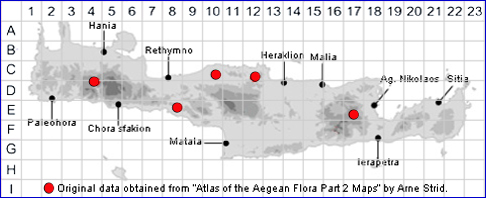
SPECIES DESCRIPTION

ALLIUM CYRILLI
Family and Genus:- See- ALLIACEAE/Sect. MELANOCROMMYUM
Common name:- None
Homotypic Synonyms:- Allium nigrum var. cyrilli, Caloscordum cyrilli.
Meaning:- Allium (L) The ancient Latin name for garlic.
Cyrilli (L) For Dominica Cyrillo (1734-99), professor of medicine at Naples.
General description:- Medium to tall bulbous perennial.
Bulbs:-
1) Up to 5 cm in diam, Ovoid, with membranous tunics.
Stems:-
1) 50-80 cm, robust.
Leaves:-
1) 3-5, 2-4 x 20-30 cm, all basal, broadly linear.
Flowers:-
1) Umbel, broadly obconica, flat-topped, dense and many-flowered.
2) Spathe, 2- or 3-valved. papery, shorter than the pedicels.
3) Perianth segments, broadly linear, ± canaliculate, acute, with incurved tips,
finally deflexed, greenish-white or purplish.
4) Filaments, flat, triangular, broader than the perianth segments at the base.
5) Ovary, purplish-black when young, later green, angular-subglobose, smooth.
Fruit:-
1) Capsule, c. 5 mm.
Key features:-
1) Stem, 50-90 cm.
2) Leaves, much shorter than the stem, up to 30 mm wide.
3) Perianth-segments 1-1·5 mm wide, broadly linear, acuminate, with the apex
incurved at anthesis.
4) Filaments, narrowly triangular, 1·5-2·5 mm wide at the base, gradually narrowed
above.
Click here for a glossary of terms used.
Habitat:- Cultivated and fallow fields, vineyards, olive groves, rarely in semi-natural habitats.
Distribution:- Scattered in mainland Greece and the Aegean. Turkey-in-Europe
and W. Anatolia, local in S. Italy. Limited distribution and rare on Crete.
Flowering time:- Apr to early June.
A member of the A. nigrum group (A. sect. Melanocrommyum), growing in the
same habitat as A. nigrum and sometimes together with it, but usually distinct in
floral characters.
Photos by:- Christodoulos Makris and Steve Lenton
Family and Genus:- See- ALLIACEAE/Sect. MELANOCROMMYUM
Common name:- None
Homotypic Synonyms:- Allium nigrum var. cyrilli, Caloscordum cyrilli.
Meaning:- Allium (L) The ancient Latin name for garlic.
Cyrilli (L) For Dominica Cyrillo (1734-99), professor of medicine at Naples.
General description:- Medium to tall bulbous perennial.
Bulbs:-
1) Up to 5 cm in diam, Ovoid, with membranous tunics.
Stems:-
1) 50-80 cm, robust.
Leaves:-
1) 3-5, 2-4 x 20-30 cm, all basal, broadly linear.
Flowers:-
1) Umbel, broadly obconica, flat-topped, dense and many-flowered.
2) Spathe, 2- or 3-valved. papery, shorter than the pedicels.
3) Perianth segments, broadly linear, ± canaliculate, acute, with incurved tips,
finally deflexed, greenish-white or purplish.
4) Filaments, flat, triangular, broader than the perianth segments at the base.
5) Ovary, purplish-black when young, later green, angular-subglobose, smooth.
Fruit:-
1) Capsule, c. 5 mm.
Key features:-
1) Stem, 50-90 cm.
2) Leaves, much shorter than the stem, up to 30 mm wide.
3) Perianth-segments 1-1·5 mm wide, broadly linear, acuminate, with the apex
incurved at anthesis.
4) Filaments, narrowly triangular, 1·5-2·5 mm wide at the base, gradually narrowed
above.
Click here for a glossary of terms used.
Habitat:- Cultivated and fallow fields, vineyards, olive groves, rarely in semi-natural habitats.
Distribution:- Scattered in mainland Greece and the Aegean. Turkey-in-Europe
and W. Anatolia, local in S. Italy. Limited distribution and rare on Crete.
Flowering time:- Apr to early June.
A member of the A. nigrum group (A. sect. Melanocrommyum), growing in the
same habitat as A. nigrum and sometimes together with it, but usually distinct in
floral characters.
Photos by:- Christodoulos Makris and Steve Lenton